现代语言学 笔记
- 格式:doc
- 大小:81.00 KB
- 文档页数:13
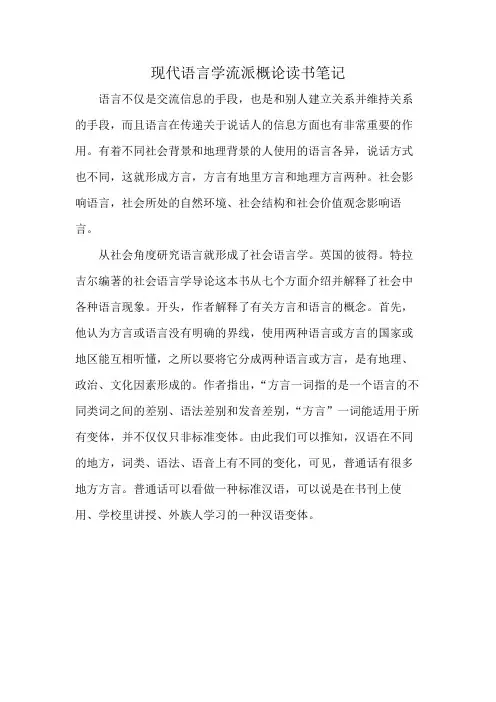
现代语言学流派概论读书笔记
语言不仅是交流信息的手段,也是和别人建立关系并维持关系的手段,而且语言在传递关于说话人的信息方面也有非常重要的作用。
有着不同社会背景和地理背景的人使用的语言各异,说话方式也不同,这就形成方言,方言有地里方言和地理方言两种。
社会影响语言,社会所处的自然环境、社会结构和社会价值观念影响语言。
从社会角度研究语言就形成了社会语言学。
英国的彼得。
特拉吉尔编著的社会语言学导论这本书从七个方面介绍并解释了社会中各种语言现象。
开头,作者解释了有关方言和语言的概念。
首先,他认为方言或语言没有明确的界线,使用两种语言或方言的国家或地区能互相听懂,之所以要将它分成两种语言或方言,是有地理、政治、文化因素形成的。
作者指出,“方言一词指的是一个语言的不同类词之间的差别、语法差别和发音差别,“方言”一词能适用于所有变体,并不仅仅只非标准变体。
由此我们可以推知,汉语在不同的地方,词类、语法、语音上有不同的变化,可见,普通话有很多地方方言。
普通话可以看做一种标准汉语,可以说是在书刊上使用、学校里讲授、外族人学习的一种汉语变体。
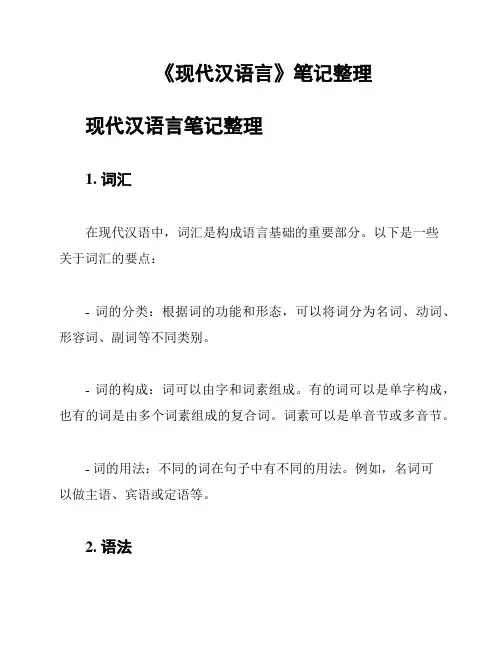
《现代汉语言》笔记整理现代汉语言笔记整理1. 词汇在现代汉语中,词汇是构成语言基础的重要部分。
以下是一些关于词汇的要点:- 词的分类:根据词的功能和形态,可以将词分为名词、动词、形容词、副词等不同类别。
- 词的构成:词可以由字和词素组成。
有的词可以是单字构成,也有的词是由多个词素组成的复合词。
词素可以是单音节或多音节。
- 词的用法:不同的词在句子中有不同的用法。
例如,名词可以做主语、宾语或定语等。
2. 语法语法是语言的结构和规则的总称。
以下是一些关于现代汉语语法的笔记:- 句子的成分:句子由主语、宾语、谓语等基本成分组成。
- 句子的结构:句子可以是简单句、并列句或复合句。
并列句和复合句可以通过连接词来连接不同的句子成分。
- 句子的语序:现代汉语的语序一般是主谓宾的顺序,但也有例外情况。
3. 语言变化语言是一种活动的、不断变化的系统。
以下是一些关于现代汉语语言变化的要点:- 词语的变化:词语可能会发生义项扩展、义项缩小、义项转移等变化。
- 语法的变化:语法规则可能会因为语言的使用惯而发生变化,例如词序的变化或者词语的用法变化。
- 语音的变化:语言的语音系统可能会因为地域、社会等因素而发生变化。
4. 语言研究研究现代汉语需要掌握以下技巧和方法:- 多读多听:通过大量的阅读和听力练,可以提高对现代汉语的理解和应用能力。
- 反复操练:反复练语言的基础知识和语法结构,以加深记忆和提高熟练度。
- 沉浸式研究:尽可能地融入到汉语环境中,与母语人士交流,提高语言应用能力。
以上是对现代汉语言的一些笔记整理,希望能对研究者有所帮助。

现代语言学教程霍凯特读书笔记摘要:现代语言学教程霍凯特读书笔记一、引言1.霍凯特及其学术贡献2.《现代语言学教程》的重要性二、语言学的基本概念1.语言的定义与功能2.语言学的研究范围与方法三、语言的构成要素1.语音2.词汇3.语法四、语言的演变与发展1.语言的起源2.语言的变迁与演化3.社会与文化对语言的影响五、语言的类型学1.语言的分类2.语言的共性与个性六、语言的认知研究1.语言与思维的关系2.语言习得与认知发展七、语言的应用领域1.语言教学与学习2.语言技术应用3.语言与跨文化交流八、结语1.《现代语言学教程》的价值与启示2.对未来语言学研究的展望正文:现代语言学教程霍凯特读书笔记霍凯特(H.Jackson)的《现代语言学教程》是一部系统阐述现代语言学基本理论、方法与应用的著作。
该书以严谨的学术态度、全面的视角和丰富的实例,为读者呈现了语言学的全貌。
以下是对该书内容的概括与解读。
一、引言霍凯特是20世纪下半叶英国著名的语言学家,他的学术贡献主要集中在历史语言学、语音学、语义学等领域。
他的《现代语言学教程》是一部经典的语言学教材,对我国现代语言学的发展产生了深远影响。
二、语言学的基本概念语言是人类的交际工具,是人类社会特有的现象。
语言学是研究语言的科学,其研究范围包括语音、词汇、语法等方面。
语言学的研究方法主要有历史比较法、实验法、观察法等。
三、语言的构成要素语音是语言的基本构成要素,包括音素、音位、音节等。
词汇是语言的基本单位,包括词汇意义、语法意义和联想意义。
语法是语言的结构规则,包括句法结构和语义结构。
四、语言的演变与发展语言起源于人类的交际需要,经历了从原始语言到现代语言的发展过程。
语言的变迁与演化受到社会、文化、历史等多种因素的影响。
五、语言的类型学语言可以根据不同的标准进行分类,如按语系、语族、语支等。
各种语言在语音、词汇、语法等方面既有共性,又有个性。
六、语言的认知研究语言与思维密切相关,语言的发展与认知发展相互作用。
![语言学纲要笔记,复习资料[1]](https://uimg.taocdn.com/823fd0ed7e21af45b307a8fb.webp)
导言1、语言学的三大发源地P1中国、印度、希腊—罗马是语言学的三大发源地。
2、传统语文学的构成部分P1文字、音韵。
训诂是我国传统语文学的构成部分,统称“小学”。
3、语言的构造P2语音、词汇和语义、语法三个部分4、语言交际的五个阶段P3编码——发送——传递——接收——编码5、语言学的概念以语言为研究对象的科学,研究探索语言的本质、结构和发展规律。
第一章语言的社会功能1、语言与言语的关系?言语是利用语言进行交际的行为和结果。
言语是个人的,语言是社会的;言语是具体的,语言是抽象的;言语是有阶级性的,语言是全民性的。
语言制约着言语,指导人们进行言语实践;语言存在于言语之中,存在于人们的交际过程之中,存在于言语行为和言语作品之中。
语言不能够脱离言语,言语也不能脱离语言,它们是不可分离的。
语言(language)和言语(parole)的区别是现代语言学奠基人索绪尔在《普通语言学教程》中提出的重要概念。
其区别表现在:第一,从运用角度来说,语言是社会共有的交际工具,相对稳定,语言是不自由的,有规则的,处于相对静止状态,语言是一个封闭的系统;言语是对语言的具体运用和由此产生的言语作品,是自由结合的,处于运用状态,言语始终是开放的。
第二,从表现形式看,语言是个音义结合的符号系统,人们要遵照这个系统的规则来使用它,是社会的,有共同性,也就是说语言属于全体社会成员;言语是人们运用语言的过程和结果,除了具有社会的因素外,还具有个人的因素,而且还要受某种特定语境的影响,从某种程度上来说,言语属于讲话者个人。
第三,语言的各个部分是有限的,抽象的;但言语是无限的,具体的。
联系表现在:第一,从历史上看,言语事实在先,规则在后,因此言语是第一性的,语言是第二性的。
哪里有言语,哪里就有语言;哪里没有言语,哪里就没有语言。
语言是存在于言语之中的,语言是从言语中抽象概括出来的模式,抽象的语言是不存在的,语言都是以言语的形式存在着的。
第二,语言来源于言语,又反作用于言语。

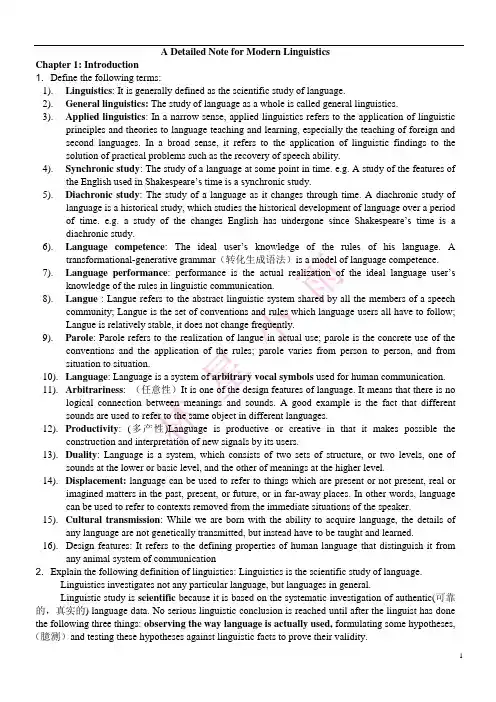
A Detailed Note for Modern LinguisticsChapter 1: Introduction1. Define the following terms:1).Linguistics: It is generally defined as the scientific study of language.2).General linguistics: The study of language as a whole is called general linguistics.3).Applied linguistics: In a narrow sense, applied linguistics refers to the application of linguisticprinciples and theories to language teaching and learning, especially the teaching of foreign and second languages. In a broad sense, it refers to the application of linguistic findings to the solution of practical problems such as the recovery of speech ability.4).Synchronic study: The study of a language at some point in time. e.g. A study of the features ofthe English used in Shakespeare’s time is a synchronic s tudy.5).Diachronic study: The study of a language as it changes through time. A diachronic study oflanguage is a historical study, which studies the historical development of language over a period of time. e.g. a study of the changes English has undergone since Shakespeare’s time is a diachronic study.6).Language competence: The ideal user’s knowledge of the rules of his language. Atransformational-generative grammar(转化生成语法)is a model of language competence.7).Language performance: performance is the actual re alization of the ideal language user’sknowledge of the rules in linguistic communication.8).Langue: Langue refers to the abstract linguistic system shared by all the members of a speechcommunity; Langue is the set of conventions and rules which language users all have to follow;Langue is relatively stable, it does not change frequently.9).Parole: Parole refers to the realization of langue in actual use; parole is the concrete use of theconventions and the application of the rules; parole varies from perso n to person, and from situation to situation.10).Language: Language is a system of arbitrary vocal symbols used for human communication.11).Arbitrariness: (任意性)It is one of the design features of language. It means that there is nological connection between meanings and sounds. A good example is the fact that different sounds are used to refer to the same object in different languages.12).Productivity: (多产性)Language is productive or creative in that it makes possible theconstruction and interpretation of new signals by its users.13).Duality: Language is a system, which consists of two sets of structure, or two levels, one ofsounds at the lower or basic level, and the other of meanings at the higher level.14).Displacement:language can be used to refer to things which are present or not present, real orimagined matters in the past, present, or future, or in far-away places. In other words, language can be used to refer to contexts removed from the immediate situations of the speaker.15).Cultural transmission: While we are born with the ability to acquire language, the details ofany language are not genetically transmitted, but instead have to be taught and learned.16).Design features: It refers to the defining properties of human language that distinguish it fromany animal system of communication2. Explain the following definition of linguistics: Linguistics is the scientific study of language.Linguistics investigates not any particular language, but languages in general.Linguistic study is scientific because it is based on the systematic investigation of authentic(可靠的,真实的) language data. No serious linguistic conclusion is reached until after the linguist has done the following three things: observing the way language is actually used, formulating some hypotheses, (臆测)and testing these hypotheses against linguistic facts to prove their validity.3. What are the branches of linguistics?What does each of them study? (语言学的主要分支是什么。

语言学概论详细笔记(总27页)--本页仅作为文档封面,使用时请直接删除即可----内页可以根据需求调整合适字体及大小--语言学概论目录目录 ................................................................................................................... 错误!未定义书签。
导言.................................................................................................................. 错误!未定义书签。
一、语言学的对象和任务 ....................................................................... 错误!未定义书签。
二、语言学的分类和分支学科................................................................ 错误!未定义书签。
三、语言学的功用 ................................................................................... 错误!未定义书签。
第一章语言的社会功能................................................................................... 错误!未定义书签。
第一节语言的社会功能 ........................................................................... 错误!未定义书签。
一、语言和说话的关系 .................................................................. 错误!未定义书签。
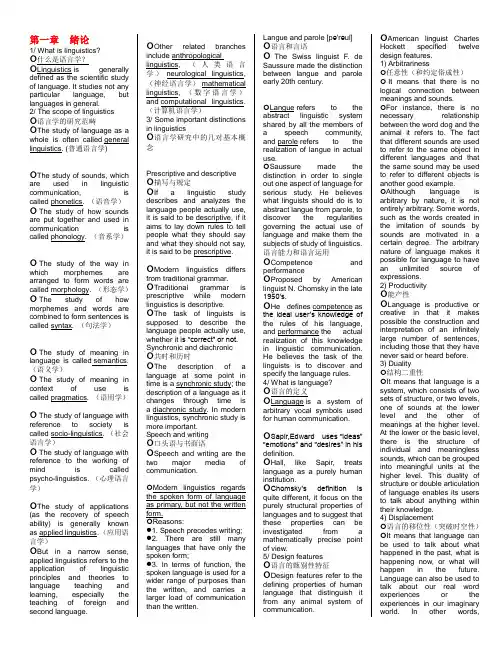
第一章绪论1/ What is linguistics?什么是语言学?Linguistics is generally defined as the scientific study of language. It studies not any particular language, but languages in general.2/ The scope of linguistics语言学的研究范畴The study of language as a whole is often called general linguistics. (普通语言学)The study of sounds, which are used in linguistic communication, is called phonetics. (语音学) The study of how sounds are put together and used in communication is called phonology. (音系学) The study of the way in which morphemes are arranged to form words are called morphology. (形态学) The study of how morphemes and words are combined to form sentences is called syntax. (句法学)The study of meaning in language is called semantics. (语义学)The study of meaning in context of use is called pragmatics. (语用学) The study of language with reference to society is called socio-linguistics. (社会语言学)The study of language with reference to the working of mind is called psycho-linguistics. (心理语言学)The study of applications (as the recovery of speech ability) is generally known as applied linguistics. (应用语言学)But in a narrow sense, applied linguistics refers to the application of linguistic principles and theories to language teaching and learning, especially the teaching of foreign and second language. Other related branchesinclude anthropologicallinguistics, (人类语言学) neurological linguistics,(神经语言学) mathematicallinguistics, (数字语言学)and computational linguistics.(计算机语言学)3/ Some important distinctionsin linguistics语言学研究中的几对基本概念Prescriptive and descriptive描写与规定If a linguistic studydescribes and analyzes thelanguage people actually use,it is said to be descriptive, if itaims to lay down rules to tellpeople what they should sayand what they should not say,it is said to be prescriptive.Modern linguistics differsfrom traditional grammar.Traditional grammar isprescriptive while modernlinguistics is descriptive.The task of linguists issupposed to describe thelanguage people actually use,whether it i s “correct” or not.Synchronic and diachronic共时和历时The description of alanguage at some point intime is a synchronic study; thedescription of a language as itchanges through time isa diachronic study. In modernlinguistics, synchronic study ismore important.Speech and writing口头语与书面语Speech and writing are thetwo major media ofcommunication.Modern linguistics regardsthe spoken form of languageas primary, but not the writtenform.Reasons:●1. Speech precedes writing;●2. There are still manylanguages that have only thespoken form;●3. In terms of function, thespoken language is used for awider range of purposes thanthe written, and carries alarger load of communicationthan the written.Langue and parole [pə'rəul]语言和言语The Swiss linguist F. deSaussure made the distinctionbetween langue and paroleearly 20th century.Langue refers to theabstract linguistic systemshared by all the members ofa speech community,and parole refers to therealization of langue in actualuse.Saussure made thedistinction in order to singleout one aspect of language forserious study. He believeswhat linguists should do is toabstract langue from parole, todiscover the regularitiesgoverning the actual use oflanguage and make them thesubjects of study of linguistics.语言能力和语言运用Competence andperformanceProposed by Americanlinguist N. Chomsky in the late1950’s.He defines competence asthe ideal user’s knowledge ofthe rules of his language,and performance the actualrealization of this knowledgein linguistic communication.He believes the task of thelinguists is to discover andspecify the language rules.4/ What is language?语言的定义Language is a system ofarbitrary vocal symbols usedfor human communication.Sapir,Edward uses “ideas”“emotions” and “desires” in hisdefinition.Hall, like Sapir, treatslanguage as a purely humaninstitution.Chomsky’s definition isquite different, it focus on thepurely structural properties oflanguages and to suggest thatthese properties can beinvestigated from amathematically precise pointof view.5/ Design features语言的甄别性特征Design features refer to thedefining properties of humanlanguage that distinguish itfrom any animal system ofcommunication.American linguist CharlesHockett specified twelvedesign features.1) Arbitrariness任意性(和约定俗成性)It means that there is nological connection betweenmeanings and sounds.For instance, there is nonecessary relationshipbetween the word dog and theanimal it refers to. The factthat different sounds are usedto refer to the same object indifferent languages and thatthe same sound may be usedto refer to different objects isanother good example.Although language isarbitrary by nature, it is notentirely arbitrary. Some words,such as the words created inthe imitation of sounds bysounds are motivated in acertain degree. The arbitrarynature of language makes itpossible for language to havean unlimited source ofexpressions.2) Productivity能产性Language is productive orcreative in that it makespossible the construction andinterpretation of an infinitelylarge number of sentences,including those that they havenever said or heard before.3) Duality结构二重性It means that language is asystem, which consists of twosets of structure, or two levels,one of sounds at the lowerlevel and the other ofmeanings at the higher level.At the lower or the basic level,there is the structure ofindividual and meaninglesssounds, which can be groupedinto meaningful units at thehigher level. This duality ofstructure or double articulationof language enables its usersto talk about anything withintheir knowledge.4) Displacement语言的移位性(突破时空性)It means that language canbe used to talk about whathappened in the past, what ishappening now, or what willhappen in the future.Language can also be used totalk about our real wordexperiences or theexperiences in our imaginaryworld. In other words,language can be used to refer to contexts removed from the immediate situations of the speaker.5) Cultural transmission文化传播性While we are born with the ability to acquire language, the details of any language are not genetically transmitted, but instead have to be taught and learned anew.********************************** Chapter 2 Phonology 音系学1.The phonic medium of language语言的声音媒介Speech and writing are the two media used by natural languages as vehicles for communication.Of the two media of language, speech is more basic than writing. Speech is prior to writing. The writing system of any language is always “invented” by its users to record speech when the need arises.For linguists, the study of sounds is of greater importance than that of writing.The limited ranges of sounds which are meaningful in human communication and are of interest to linguistic studies are the phonic medium of language (语言的声音媒介) .The individual sounds within this range are the speech sounds (语音).2.What is phonetics?什么是语音学?Phonetics is defined as the study of the phonic medium of language;It is concerned with all the sounds that occur in the world’s languages.语音学研究的对象是语言的声音媒介,即人类语言中使用的全部语音。
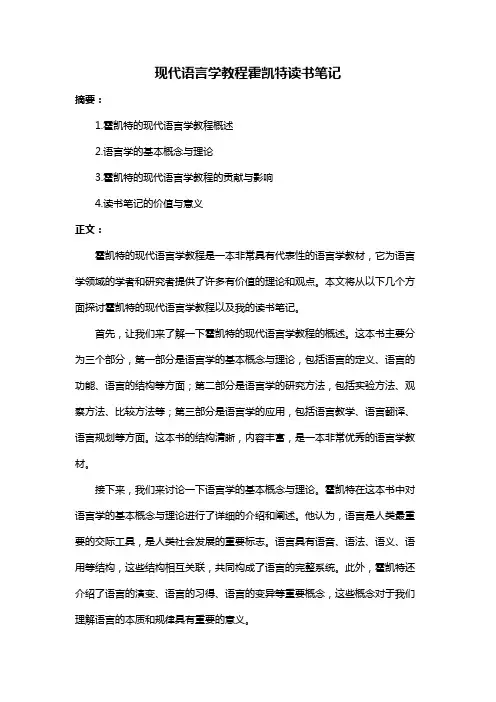
现代语言学教程霍凯特读书笔记摘要:1.霍凯特的现代语言学教程概述2.语言学的基本概念与理论3.霍凯特的现代语言学教程的贡献与影响4.读书笔记的价值与意义正文:霍凯特的现代语言学教程是一本非常具有代表性的语言学教材,它为语言学领域的学者和研究者提供了许多有价值的理论和观点。
本文将从以下几个方面探讨霍凯特的现代语言学教程以及我的读书笔记。
首先,让我们来了解一下霍凯特的现代语言学教程的概述。
这本书主要分为三个部分,第一部分是语言学的基本概念与理论,包括语言的定义、语言的功能、语言的结构等方面;第二部分是语言学的研究方法,包括实验方法、观察方法、比较方法等;第三部分是语言学的应用,包括语言教学、语言翻译、语言规划等方面。
这本书的结构清晰,内容丰富,是一本非常优秀的语言学教材。
接下来,我们来讨论一下语言学的基本概念与理论。
霍凯特在这本书中对语言学的基本概念与理论进行了详细的介绍和阐述。
他认为,语言是人类最重要的交际工具,是人类社会发展的重要标志。
语言具有语音、语法、语义、语用等结构,这些结构相互关联,共同构成了语言的完整系统。
此外,霍凯特还介绍了语言的演变、语言的习得、语言的变异等重要概念,这些概念对于我们理解语言的本质和规律具有重要的意义。
再来看一下霍凯特的现代语言学教程的贡献与影响。
这本书对于语言学的发展具有重要的贡献,它不仅提供了许多有价值的理论和观点,而且也为语言学的研究提供了新的思路和方法。
此外,这本书对于语言学的教学和应用也产生了深远的影响,它成为了许多语言学课程的主要教材,也为语言工作者提供了重要的参考资料。
最后,我们来谈一下读书笔记的价值与意义。
读书笔记是一种非常重要的学习方法,它可以帮助我们整理思路,加深理解,提高记忆。
读书笔记也可以帮助我们发现问题,思考问题,解决问题。
因此,读书笔记对于我们的学习和研究具有重要的价值和意义。
总的来说,霍凯特的现代语言学教程是一本非常优秀的语言学教材,它为我们提供了许多有价值的理论和观点。


中国现代语言学史何九盈读书笔记以下是中国现代语言学史何九盈读书笔记的正文和拓展:正文:何九盈先生的《中国现代语言学史》是一部系统论述中国现代语言学发展的著作。
该书分为四个部分,分别是语言学理论的发展;语言学应用的发展;方言学和民族语言学的发展;以及现代汉语语法和词汇的发展。
在第一部分中,何九盈先生介绍了语言学理论的起源和发展,包括语音学、语义学、语用学、语言学历史学派等理论。
他还介绍了中国语言学家的语言学理论探索,如王力先生的“两系说”、赵元任先生的“语音中心说”等。
在第二部分中,何九盈先生介绍了语言学应用的发展,包括语言学在文学、法律、医学、军事等领域的应用。
他还介绍了中国语言学家在这些方面的贡献,如鲁迅、林语堂、老舍等文学家对语言学的应用研究,以及钱学森等人在军事语言学方面的贡献。
在第三部分中,何九盈先生介绍了方言学和民族语言学的发展。
他介绍了中国语言学家对方言和少数民族语言的研究,如李方桂等人对广东话的研究、黄伯荣等人对壮语的研究等。
此外,他还介绍了中国语言学家对少数民族文化和语言的保护和发展,如云南少数民族语言调查、少数民族文字的抢救和保护等。
在第四部分中,何九盈先生介绍了现代汉语语法和词汇的发展。
他介绍了中国语言学家对现代汉语语法和词汇的研究,如朱德熙等人的语法研究、黄伯荣等人的词汇研究等。
此外,他还介绍了中国语言学家对现代汉语规范和标准化的研究,如现代汉语词典的编纂、普通话的推广等。
拓展:除了上述内容外,中国现代语言学史还有许多其他重要的事件和人物值得介绍。
以下是一些可能的拓展内容:1. 民国时期的语言学运动:民国时期出现了一股语言学运动,主要由语言学家陈寅恪、周有光、鲁迅等人倡导。
这场运动强调了语言学的科学性和人文价值,促进了语言学的研究和发展。
2. 方言调查和方言研究:方言调查和方言研究是中国现代语言学发展的重要组成部分。
Chapter one linguistics•1.1 Definition of linguistics:• the scientific study of language• (lingui-:language; -ics:science)•1.2. History of linguistics• before the mid of 19th century: philology• (语文学)• from the mid of 19th century: linguistics• (语言学)•1.2.1 Ferdinand de Saussure (索绪尔)–1857-1913–Swiss linguist–Famous for his book Course in General Linguistics–Published in 1916, after his death–Based on lecture notes taken by students–Father of modern linguistics–Drew several very important distinctions in the study of language (see blow) •Distinguish between synchronic and diachronic studies of language–language can be studied synchronically–does not need to consider history•Distinguish between langue and parole–treat language as a system–define the units of language–study the relations among units and the rules of combination ••Synchronic study–study the language system at a given period–treat the system as being static–concentrate on one language and on the speaker’s knowledge of the language ••Diachronic study–study the language systems in different periods–concentrate on how languages change–often needs to study several different languagesLangue vs. parole(language vs. speech)•the system of language•a set of social conventions•exists in the mind of each speaker•learned by each speaker•all speakers have the same system•more or less fixed•a speaker is powerless to create it or modify it•actual speech•an individual act of the will and the intelligence•a speaker has freedom in uttering sentences, is free to choose what to say •ancillary/accidental•The speeches of two speakers may be rather different ••Competenc e:-the ideal knowledge of the speaker-a property of the mind of each speakercompetence = knowledge of grammar•Performance-actual realization of this knowledge in utterance-influenced by psychological & social factors•Theoretical lin guistics (理论语言学)–Phonetics–Phonology–Morphology–Syntax–Semantics–*Pragmatics–*Discourse Analysis (会话分析)–*Text analysis (语篇学)Chapter 2 Language•2.1. Definition of language:language is a system of arbitrary vocal symbols used for human communication •2.2. Design features of language:(1) duality (双重性):language is composed of 2 systems.system of sounds: meaningless, limited numbersystem of meanings:meaningful, relatively unlimited•(2). Arbitrariness(任意性)-The combination of the sound and meaning of linguistic symbols is a social convention.-there is no necessary or intrinsic connection between the symbols,and the meaning of the symbols•(3). Productivity (生成性)-Productivity refers to the property that language enables language users to produce or understand an indefinite number of sentences including novel sentences.-No one will have difficulty in understanding the sentence: “the terrorists will bo mb the railway of Tokoy tomorrow.”-But the communication systems of other animals are not productive.•(4). Displacement(移位性)•-Displacement is the property of language that enables language users to overcome the barriers caused by time and place.people can talk about things present,absent,in the past, in the future.•(Queen Elizabeth Ⅰ)•(5).cultural transmission(文化传递性)-Language and culture are closely related to each other.-Language is passed on from generation to generation by learning rather by instinct.-Language is culturally transmitted.2.3. Functions of language(what language is used for)•(1).phatic:-Phatic function refers to language used for establishing an atmosphere or maintaining social contact rather than for exchanging information or ideas.-Greeting,farewells, and comments on the weather server the function. Such as, “How are you?”, “A nice day, isn’t it?”•(2). Directive-When language is used to get the hearer do something,it serves a directive function.-Most imperative sentences are associated with this function. Such as in “come in, please.”, “Drop in any time you like.”•(3). Informative- Language serves an informative function when it is used to to give information about facts, tell what the speaker believes.- Most declarative sentences, as well as rhetorical questions are used to serve this function.•(4). Interrogative-When language is used to get information from others, it serves an interrogative function.-All the questions that expe ct answers serve this function. Such as , “what is your name?” or “Are you able to speak Japanese?”•(5). Expressive-Expressive function is the use of language to reveal something abut the feelings and attitudes of the speaker.-In expressive funct ion, language is used to evaluate and assert the speaker’s attitudes.-Some ejaculations are the examples ,such as, “oh, my God!” or “The man is leaving ,I wish to God he would go!”•(6). Evocative-Evocative function is the use of language to create certain feeling in the hearer.-Evocative function aims to amuse, startle, anger, soothe, worry, or please the hearer.-Jokes, advertising, propaganda are used to serve the evocative function of language. Such as,Coke refreshes you like no other can.If it is got to be clean, it’s got to be tide.•(7). Performative-When language is used to “do things”, , to perform actions, it serves the performative function.-With the sentences being uttered, the act can be performed, such as, “I declare the exam is cancelled.” or‘ I declare the class is over.”Chapter 3 Phonetics (语音学)•3.1. Definition of Phonetics (语音学):Phonetics is the scientific study of speech sounds•Deals with speech sounds•Concerns all possible sounds humans can make3.2. The three main branches of Phonetics:•Articulatory (发音) Phonetics:•the study of the production of speech sound.•Acoustic (声学) Phonetics:•the study of the physical properties of the sounds produced in speech. •Auditory (听觉) Phonetics:•the perception of speech sounds.Chapter 3 Phonetics (语音学)•3.1. Definition of Phonetics (语音学):Phonetics is the scientific study of speech sounds •Deals with speech sounds•Concerns all possible sounds humans can make3.2. The three main branches of Phonetics:•Articulatory (发音) Phonetics:•the study of the production of speech sound.•Acoustic (声学) Phonetics:•the study of the physical properties of the sounds produced in speech. •Auditory (听觉) Phonetics:•the perception of speech sounds•3.3 Speech Organs•Lips (labia唇)•Teeth (dentes齿)•Tooth-ridge (alveoli齿龈)•Hard palate ( 硬腭)•Soft palate (velum软腭)•Uvula (小舌)•Tip of tongue (舌尖)•Blade of tongue (舌面)•Front of tongue (舌前部)•Back of tongue (舌后部)•Tongue root (舌根)•Pharynx (声门)•V ocal cords (声带)•Nasal cavity (鼻腔)•Oral cavity (口腔)•Epiglottis (会厌)•Tongue (lingua) (舌)3.4. Phonetic transcription (注音)•A sound may have many variationsExample 1:•[p] in peak is aspirated ↔ [ph]•[p] in speak is unaspirated ↔ [p=] or simply [p] Example 2:•[l] in lead is clear↔ [l]•[l] in deal is dark ↔[ł]•Symbols for such more specific sounds are called diacritics (变音符) •See胡壮麟, 语言学教程, p. 38Narrow transcription& Broad transcription•Narrow transcription:•use more, specific symbols,i.e. diacratics•Broad transcription:•Use ordinary symbolsExample: helpBroad transcription: [help]Narrow transcription: [hełph]Commonly used diacratics: 。
语言学笔记一、语言学的定义和研究对象语言学是研究语言现象的学科,主要研究人类语言的性质、结构、发展及其在社会生活中的运用。
语言学的研究对象包括语言的语音、语法、语义、语用等方面。
二、语言的基本特征1. 符号性:语言是一种符号系统,符号包括能指和所指两个方面。
能指是符号的物质形式,所指是符号所代表的意义。
2. 任意性:语言符号的能指和所指之间的关系是任意的,没有必然的联系。
这种任意性是语言符号系统的基础。
3. 层次性:语言结构具有层次性,包括语音层、语法层、语义层和语用层等。
每个层次都有其独特的结构和规则。
4. 生成性:语言具有生成性,即有限的语言规则可以生成无限多的语言表达式。
这是语言创造力的重要体现。
5. 社会性:语言是一种社会现象,是社会交际的工具。
语言的运用受到社会文化、经济、政治等多种因素的影响。
三、语言学的主要分支1. 语音学:研究语言的语音系统,包括音位、音变、音系等方面的研究。
2. 音系学:研究语言的音节结构和音系规则,揭示语言的音节组成和音系演变规律。
3. 形态学:研究词的内部结构和构词规则,揭示词的形态变化和构词规律。
4. 句法学:研究句子的结构规则和组合规律,揭示句子的句法关系和语义关系。
5. 语义学:研究语言的意义系统,包括词义、句义、篇章意义等方面的研究。
6. 语用学:研究语言在实际运用中的功能和效果,包括语境、会话含义、言语行为等方面的研究。
四、语言学的研究方法1. 描述法:对语言现象进行客观描述和分析,揭示语言的本质特征和规律。
2. 比较法:通过对不同语言或同一语言不同方言的比较研究,揭示语言的共性和差异。
3. 实验法:通过实验手段对语言现象进行实证研究,验证语言学理论和假设。
4. 历史法:通过对语言历史演变的研究,揭示语言的发展规律和演变趋势。
5. 数学法:运用数学方法和模型对语言现象进行定量分析和模拟研究,揭示语言的数学模型和内在规律。
五、语言学的学习意义和价值1. 提高语言能力:通过学习语言学知识,可以更好地掌握和运用语言,提高听说读写译等语言能力。
第一章绪论1/ What is linguistics?什么是语言学?Linguistics is generally defined as the scientific study of language. It studies not any particular language, but languages in general.2/ The scope of linguistics语言学的研究范畴The study of language as a whole is often called general linguistics. (普通语言学)The study of sounds, which are used in linguistic communication, is called phonetics. (语音学) The study of how sounds are put together and used in communication is called phonology. (音系学)The study of the way in which morphemes are arranged to form words are called morphology. (形态学) The study of how morphemes and words are combined to form sentences is called syntax. (句法学)The study of meaning in language is called semantics. (语义学)The study of meaning in context of use is called pragmatics. (语用学) The study of language with reference to society is called socio-linguistics. (社会语言学)The study of language with reference to the working of mind is called psycho-linguistics. (心理语言学)The study of applications (as the recovery of speech ability) is generally known as applied linguistics. (应用语言学)But in a narrow sense, applied linguistics refers to the application of linguistic principles and theories to language teaching and learning, especially the teaching of foreign and second language.Other related branches include anthropological linguistics, (人类语言学) neurological linguistics,(神经语言学) mathematicallinguistics, (数字语言学)and computational linguistics.(计算机语言学)3/ Some important distinctionsin linguistics语言学研究中的几对基本概念Prescriptive and descriptive描写与规定If a linguistic studydescribes and analyzes thelanguage people actually use,it is said to be descriptive, if itaims to lay down rules to tellpeople what they should sayand what they should not say,it is said to be prescriptive.Modern linguistics differsfrom traditional grammar.Traditional grammar isprescriptive while modernlinguistics is descriptive.The task of linguists issupposed to describe thelanguage people actually use,whether it i s “correct” or not.Synchronic and diachronic共时和历时The description of alanguage at some point intime is a synchronic study; thedescription of a language as itchanges through time isa diachronic study. In modernlinguistics, synchronic study ismore important.Speech and writing口头语与书面语Speech and writing are thetwo major media ofcommunication.Modern linguistics regardsthe spoken form of languageas primary, but not the writtenform.Reasons:●1. Speech precedes writing;●2. There are still manylanguages that have only thespoken form;●3. In terms of function, thespoken language is used for awider range of purposes thanthe written, and carries alarger load of communicationthan the written.Langue and parole [pə'rəul]语言和言语The Swiss linguist F. deSaussure made the distinctionbetween langue and paroleearly 20th century.Langue refers to theabstract linguistic systemshared by all the members ofa speech community,and parole refers to therealization of langue in actualuse.Saussure made thedistinction in order to singleout one aspect of language forserious study. He believeswhat linguists should do is toabstract langue from parole, todiscover the regularitiesgoverning the actual use oflanguage and make them thesubjects of study of linguistics.语言能力和语言运用Competence andperformanceProposed by Americanlinguist N. Chomsky in the late1950’s.He defines competence asthe ideal user’s knowledge ofthe rules of his language,and performance the actualrealization of this knowledgein linguistic communication.He believes the task of thelinguists is to discover andspecify the language rules.4/ What is language?语言的定义Language is a system ofarbitrary vocal symbols usedfor human communication.Sapir,Edward uses “ideas”“emotions” and “desires” in hisdefinition.Hall, like Sapir, treatslanguage as a purely humaninstitution.Chomsky’s definition isquite different, it focus on thepurely structural properties oflanguages and to suggest thatthese properties can beinvestigated from amathematically precise pointof view.5/ Design features语言的甄别性特征Design features refer to thedefining properties of humanlanguage that distinguish itfrom any animal system ofcommunication.American linguist CharlesHockett specified twelvedesign features.1) Arbitrariness任意性(和约定俗成性)It means that there is nological connection betweenmeanings and sounds.For instance, there is nonecessary relationshipbetween the word dog and theanimal it refers to. The factthat different sounds are usedto refer to the same object indifferent languages and thatthe same sound may be usedto refer to different objects isanother good example.Although language isarbitrary by nature, it is notentirely arbitrary. Some words,such as the words created inthe imitation of sounds bysounds are motivated in acertain degree. The arbitrarynature of language makes itpossible for language to havean unlimited source ofexpressions.2) Productivity能产性Language is productive orcreative in that it makespossible the construction andinterpretation of an infinitelylarge number of sentences,including those that they havenever said or heard before.3) Duality结构二重性It means that language is asystem, which consists of twosets of structure, or two levels,one of sounds at the lowerlevel and the other ofmeanings at the higher level.At the lower or the basic level,there is the structure ofindividual and meaninglesssounds, which can be groupedinto meaningful units at thehigher level. This duality ofstructure or double articulationof language enables its usersto talk about anything withintheir knowledge.4) Displacement语言的移位性(突破时空性)It means that language canbe used to talk about whathappened in the past, what ishappening now, or what willhappen in the future.Language can also be used totalk about our real wordexperiences or theexperiences in our imaginaryworld. In other words,language can be used to referto contexts removed from theimmediate situations of thespeaker.5) Cultural transmission文化传播性While we are born with theability to acquire language, thedetails of any language arenot genetically transmitted,but instead have to be taughtand learned anew.**********************************Chapter 2Phonology 音系学1.The phonic medium oflanguage语言的声音媒介Speech and writing are the two media used by natural languages as vehicles for communication.Of the two media of language, speech is more basic than writing. Speech is prior to writing. The writing system of any language is always “invented” by its users to record speech when the need arises.For linguists, the study of sounds is of greater importance than that of writing.The limited ranges of sounds which are meaningful in human communication and are of interest to linguistic studies are the phonic medium of language (语言的声音媒介) .The individual sounds within this range are the speech sounds (语音).2.What is phonetics?什么是语音学?Phonetics is defined as the study of the phonic medium of language;It is concerned with all the sounds that occur in the world’s languages.语音学研究的对象是语言的声音媒介,即人类语言中使用的全部语音。
现代语言学学习笔记第一章、绪论Introduction1、语言学的主要分支是什么。
每个分支的研究对象是什么?Linguistics mainly involves the following branches:General linguistics, which is the study of language as a whole and which deals with the basic concepts, theories, descriptions, models and methods applicable in any linguistic studyPhonetics, which studies the sounds that are used in linguistic communication Phonology, which studies how sounds are put together and used in communication Morphology, which studies the way in which morphemes are arranged to form wordsSyntax, which studies how morphemes and words are combined to form sentences Semantics, which is the study of meaning in language.Pragmatics, which is the study of meaning not in isolation, but in context of use Sociolinguistics, which is the study of language with reference to society Psycholinguistics, which is the study of language with reference to the workings of mind.Applied linguistics, which is concerned about the application of linguistic findings in linguistic studies; In a narrow sense, applied linguistics refers to the application of linguistic principles and theories to language teaching and learning, especially the teaching of foreign and second languages.Other related branches are anthropological linguistics, neurological linguistics, mathematical linguistics, and computational linguistics.2、现代语言学与传统语法有什么区别?Traditional grammar is prescriptive; it is based on "high "(religious, literary) written language . It sets models for language users to follow. But Modern linguistics is descriptive; its investigations are based on authentic, and mainly spoken language data. It is supposed to be scientific and objective and the task of linguists is supposed to describe the language people actually use, whether it is "correct" or not.3、什么叫共时研究?什么叫历时研究?The description of a language at some point in time is a Synchronic study; the description of a language as it changes through time is a diachronic study. A synchronic study of language describes a language as it is at some particular point in rime, while a diachronic study of language is a historical study; it studies the historical development of language over a period of time.4、人类语言的甄别性特征是什么?1) Arbitrariness 。
语言学纲要笔记(总11页)--本页仅作为文档封面,使用时请直接删除即可----内页可以根据需求调整合适字体及大小--语言学纲要思考题(导言)导言1. 语言学的研究对象和任务是什么语言学的研究对象是语言,因此,语言学是专门以语言为研究对象的社会科学。
学习语言学使我们能对语言的本质和结构有个理性的认识,对我们从事语言文学工作都有很大的帮助。
语言学的基本任务是研究语言的规律和特点。
具体任务是:a. 描写语言在某一发展阶段的面貌;b. 推溯语言的演变过程,揭示其发展规律;c. 对不同语言进行各种比较,找出它们的异同或对应关系。
这种比较包括共时比较和历时比较两种。
2. 语言学与其他学科的关系怎样现代语言学的发展不仅同哲学、历史学等社会科学和文学有着十分密切的关系,而且和自然科学发生愈来愈密切的关系。
围绕着语言学,正在兴起许多有广阔前途的边缘科学。
例如:a. 社会语言学,把语言结构运用的各个方面跟社会环境结合起来研究,它涉及到语言和方言、语言和民族、语言和文化、语言和政治等一系列问题;b. 心理语言学,着重研究人类大脑的语言机制,如人是怎样学会说话的等等;c. 数理语言学,主要是运用数学中的一些理论和方法来分析和描写语言的结构,目前比较多的是用在人工语言中;d. 计算语言学,它主要利用电子计算机进行语言研究;e. 应用语言学,有广义和狭义的两种理解,广义的泛指语言学的各种运用,甚至包括计算语言学和数理语言学在内,狭义的专指把语言理论应用于语言教学(包括本族语教学和外语教学);f. 病理语言学,通过言语现象来判断和治疗言语障碍等疾病;g. 神经语言学,通过神经控制系统来研究雁产生的过程和言语的生理系统。
近年来,由于电子计算机的发展和广泛应用,语言学家和科学家们正在研究人工语言(为计算机设计的语言)同自然语言之间的关系。
3. 语言学的主要功用是什么语言学在我国社会主义建设中的功用,表现在以下几个方面:A. 为贯彻党的语文政策服务,促进祖国语言的纯洁和健康;B. 为现代科学技术服务,推动社会生产力的发展;C. 为语文教学和语文工作服务,提高全民族的文化水平;D. 为贯彻执行我国的民族政策服务,发展少数民族科学文化事业;E. 为建设社会主义精神文明服务,促进现代化建设。
Introduction一、Linguistics: It is generally defined as the scientific study of language.二、The scope of linguistics1、phonetics: How speech sounds are produced and classified.2、phonology: How speech sounds form systems and function to convey the meaning3、morphology: How morphemes are combined to form words4、syntax: How morphemes and words are combined to form sentences5、semantics: The study of meaning (in abstraction.)6、pragmatics: The study of meaning in context of use7、sociolinguistics :The study of language with reference to society8、psycholinguistics: The study of language with reference to working of the mind9.applied linguistics: the application of linguistic principles and theories to language teaching and learning.三、Some important distinction in linguistics1、descriptive(描述性) :A linguistic study describes and analyzes the language people actually use.2、prescriptive(规定性): It aims to lay down rules for ―correct‖ behaviors. i.e. what they should say and what they should not to say.1、synchronic(共时语言学): It refers to the study of variation in language in different places and among different groups at a given point in time.2、diachronic (历时语言学): Studies language change over various periods of time and at various historical stages.1、speech2、writing are the two media of communication. Modern linguistics regards the spoken language as primary, not the written.1、langue(语言): refers to abstract linguistic system shared by all the members of the speech community. It is the set of conventions and rules which language users all have to abide by. Such as: In English sentence must have subject and predicate.2、parole(言语):refers to the realization of langue in actual use. It is concrete use of the conventions and the application of the rules.1、competence(语言能力):As the ideal user‘s knowledge of the rules of his language2、performance(语言应用):the actual realization of his knowledge in linguistic communication.四、What is language?Language is a system of arbitrary vocal symbols used for human communication.Language is a system i.e. elements of language are combined according to rules.Language is arbitrary .because the fact that different languages have different words for the some object.Language is vocal because the primary medium is sound for all languages.Language is symbols.The term ―human‖ in the definition is meant to specify that language is human specific.五、design features(识别特征)Design features refer to the defining properties of human language that distinguish it from any animal system of communication. There are twelve design features, but this book only tell us five of them.Arbitrariness: there is no logical connection between meanings and sounds .A good example is the fact that different sounds are used to refer to the same object in different language, but it is not entirely arbitrary.Productivity: language make possible the construction and interpretation of new signals by it users. Productivity is unique to human language.Duality(二重性):Language is a system, which consists of two sets of structures, or two levels at the lower or the basic level there is a structure of sounds, which are meaningless. But the sounds of language can be grouped and regrouped into a large number of units of meaning such as morphemes and words. Displacement: Language can be used to refer to things which are present or not present, real or imagined matters in past, present or future. or in far-away place. In other words, language can be used to refer to context removed from the immediate situations of speakers.Phonology一、phoneticsThe speech and writing are two media or substance used by natural language as vehicles for communication.Linguists are not interested in all sounds; they are concerned with only those sounds that are produced by the human speech organs.Pho netics is defined as the study of phonic medium of language. It‘s concerned with all sounds that occur in the world‘s language.Phonetics looks at speech sounds from 3distinct but related point of view. They are:Articulation phonetics(发音语音学):How a speaker uses his speech organs articulate the sounds.Auditory phonetics(听觉语音学):How a hearer perceives the sounds. Acoustic(声学语音学):How the sounds are transmitter.Organs: pharyngeal cavity–the throat oral cavity—the mouth nasal cavity—the noseVoiceless: when the vocal cords are drawn wide apart, letting air go through without causing vibration.Voicing: sounds produced while the vocal cords are vibratingBroad transcription: the transcription with the letter-symbols onlyNarrow transcription: the transcription with the letter-symbols and the diacritics. English sounds can be classified two categories: vowels and consonants Consonants: the sounds in the production of which there is an obstruction ofthe air steam at some point of the vocal tract.Vowels: the sounds in the production of which no articulators come very close together and the air stream passes through the vocal tract without obstruction. Phonology: the study of sound system—the inventory of distinctive sounds that occur in a language and the patterns into which they fall.Phonetics and phonology: are studies of speech sounds. Phonetics is interested in all speech sound in the world‘s language: how they are produced and classified. Phonology is interested in the system of sounds of a particular language; it aims to discover how speech sounds in a language form patterns, and how these sounds are used to convey meaning in linguistic communication. Phone(音素): Is defined as the speech sounds we use when speaking a language. A phone is a phonetic unit or segment. It does not necessarily distinguish meaning; some do, some don‘t.Phoneme(音位): It is basic unit in phonology; it is collection of distinctive phonetic features.Allophone(音位变体):Different phones which can represent a phoneme in different phonetic environments are called allophones of that phoneme. Phonemic contrast(音位对立);Complementary(音位互补);Minimal pair(最小对立):Two sound combinations identical in every way except in one sound element that occurs in the same position.Some rules in phonology: 1Sequential rules,2Assimilation rules (one sound to another by ―copying‖ a feature of a sequential phoneme, thus make the two phones similar) 3Deletion rule (it tell us when a sound is to be deleted although it is orthographically represented.) Suprasegmental features: the phonemic features that occur above the level of the segments .the main suprasegmental features are: stress, tone, intonation. MorphologyIt is a branch of grammar which studies the internal structure of words and the rules that form the words.Morphology is two sub-branch: inflectional morphology and lexical or derivational morphology.Morpheme: the smallest meaningful unit of language. (A phoneme is the basic unit in the study of phonology, so is a morpheme the basic unit in the study of morphology.)Type of morphemes: free morphemes and bound morphemes (include root and affixes)Free morphemes: are independent units of meaning and can be used freely all by themselves. For example: boy.Bound morphemes: can not be used independently but have to be combined with other morphemes, either free or bound, to form a word.Roots: A root is often seen as a part of a word, it can never stand by itself although it bears clear, definite meaning; it must be combined with another root or an affix to form a word. Such roots are numerous in English for example: "geo-―bears the meaning of ―the earth‖. When it combines with another root―-ology‖meaning ―a branch of learning‖, we got the word ―geology‖ which means ―the study of the earth‘s structure.Affixes are two types: inflectional affixes (inflectional morpheme) and derivational affixes.Inflectional affixes: manifest various grammatical relations or grammatical categories such as number, tense, degree, and case.-(e)s, indicating plurality of nouns.-(e)s, indicating third person singular, present tense.-(e)d, indicating past tense for all three persons.-ing, indicating progressive aspect.-er, indicating comparative degree of adjectives and adverbs.-est, indicating superlative degree of adjectives and adverbs.-‗s, indicating the possessive case of nouns.Derivational affixes: are added to an existing form to create a word. Such a way of word-formation is called derivation and the new word formed by derivation is called a derivative.The existing form to which a derivational affix can be added is called a stem Affixes can be divided into two kinds: prefixes and suffixes. Prefixes and SuffixesPrefixes occur at the beginning of a word, modify the meaning of the stem, but usually do not change the part of speech of the original word.Suffixes at the end of a word, are added to the end of stems. They modify the meaning of the original word and in many cases change its part of speech. Compounding is popular and important way of forming new words in English. In terms of morphemic analysis, derivation can be viewed ad the addition of affixes to stems to form new words, and compounding the combination of two or sometimes more than two words to create new words.Features of compounds1.orthographically(拼写特征): a compound can be written as one with or without a hyphen, or as two separate words. For example: armchair, follow-up, thunder bird.2.syntactically(句法特征): the part of speech of the compound is generally determined by the part of speech of the second element. For example: ice-cold (adj.) greenhouse (noun).3.sematically(语意特征): the meaning of a compound is often idiomatic, not always being the sum total of the meanings of the meanings of its components. For example: a blackleg is not a leg that is black, it means cheater4.phonetically(语音特征): the stress of a compound always falls on the first element, while the second element receives secondary stress.SyntaxSyntax is a subfield of linguistics that studies the sentence structure of language. Sentences are structured according to particular arrangement of words.Syntax as a system of rules. as a major component of grammar, syntax consistsof a set of abstract rules that allow words to be combined with other words to form grammatical sentencesSentence structureSubject all language have ways of referring to some entity, such as a person , a place, a thing, an idea, or an event, this referring expression is grammatically called subject. A subject may be a noun or a noun phrase in a sentence that usually precedes the predicate.Type of sentence1. The simple sentence: a simple sentence consists of a single clause which contains a subject and a predicate and stands alone as its own sentence. For example: John reads extensively. Mary decided to take a linguistics class the next semester.2. The coordinate sentence: a coordinate sentence contains two clauses joined by a linking word called coordinating conjunction, such as ―and‖, ―but‖, ―or‖. The two clauses in a coordinate sentence are structurally equal parts of the sentence; neither is subordinate to the other. In another words, each clause is separable from the other and can stand on its own as a structurally independent sentence.3. The complex sentence: a complex sentence contains two, or more, clauses, one which is incorporated into another. That is, the two clauses in complex sentence hold unequal status, one subordinating the other. The incorporated, or subordinated, clause is normally called an embedded clause, and the clause into which it is embedded is called matrix clause.Some conclusions can be drawn from the complex sentence.1. an embedded clause functions as a grammatical unit in its matrix clause.2.most embedded clauses require an introductory word called a s ubordinator, such as ―that‖,‖ if ‖.3.an embedded clause may not function as a grammatically well-formed sentence if it stands independently as a simple sentence unless it form changes. Language is a highly structured system of communication. Sentences are not formed by randomly(随意)combining lexical items, but by following a set of syntactic rules that arrange linguistic elements in a particular order to make a string of words not only meaningful but also linearly- and hierarchically-structured.(线形结构和层次结构)Hierarchical structure: the sentence structure that groups words into structural constituents and shows the syntactic categories of each structural constituent, such as NP and VP.Syntactic categories: 1. lexical categories (four major lexical categories and six minor lexical categories) 2. Phrasal categories (lexical items have certain combinational properties that allow them to combine with words of different categories to form phrase. NP VP PP AP)Grammatical relations(语法关系) the structural and logical functional relations between every noun phrase and sentence.S-structure(表层结构): A level of syntactic representation after the operation of necessary syntactic movement.X-bar: a general and highly abstract schema that collapses all phrase structure rules into a single format: x‖—(spec) X (comp.)General grammar: a system of linguistic knowledge which consists of some general principles and parameters about natural language.Move α:A general movement rule accounting for th e syntactic behavior of any constituent movement.Semantics can be simply defined as the study of meaning.Some views concerning the study of meaning:1. The naming theory. One of the oldest notions concerning meaning, and alsoa very primitive one, was the naming theory proposed by the ancient Greek scholar Plato. The words used in a language are taken to be labels of the objects they stand for.2. The conceptualist view(意念论): was holds that there is no direct link between a linguistic form and what it refers to (i.e., between language and the real world); rather, in the interpretation(解释)of meaning they are linked through the mediation of concepts in the mind. This view is suggested by Ogden and Richards.3.Contextualism(语境论):contextualism is based on the presumption(假定)that one can derive(推导) meaning from or reduce meaning to observable(可观测的) contexts. Two kinds of context are recognized, the situational context and the linguistic context.4. Behaviorism(行为主义论): behaviorism refers to the attempt(企图) to define the meaning of a language form as the ―situation in which the speaker utter it and the response it calls forth in the hearer‖(Bloomfied,1933). This theory somewhat close to contextualism emphasizes on the psychological response. Sense and referenceReference(所指意义): Reference means what a linguistic form refers to in the real, physical world; it deals with the relationship between the linguistic element and the non-linguistic world of experience.Sense(意义):Sense is concerned with the inherent meaning of the linguistic form. It is the collection of all the features of the linguistic form; it is abstract and de-contextualized.Major sense relations:1.synonymy(同义): refers to the sameness or close similarity of meaning. Words that are close in meaning are called synonyms.Synonymy can be divided into the following groups:①Dialectal synonyms(地域性同义词)---synonyms used in different regional dialects. These are words with more or less the same meaning used in different regional dialects. Such as: American English and British English.②Stylistic synonyms (文体同义词)--- synonyms differing in style. Words having the same meaning may differ in style, or degree of formality(礼节). Such as: old man ,daddy, father.③synonyms that differ in their emotive or evaluative meaning.④collocational synonyms(搭配上的区别)⑤semantically different synonyms(语意上的差别)。